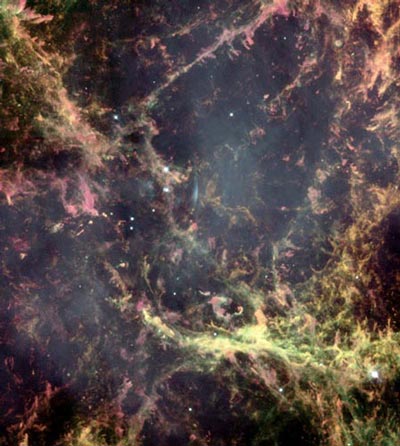Astronomy Picture of the Day
Discover the cosmos! Each day a different image or photograph of our fascinating universe is featured, along with a brief explanation written by a professional astronomer.

Credit: William P. Blair (JHU) et al. Hubble Heritage Team (STScI/AURA), NASA |
Explanation: The supernova explosion that formed the Crab Nebula was first seen on the year 1054. Last week, astronomers released a new image of the still-evolving centre of the explosion. The above representative-colour photograph was taken in colours emitted by specific elements including hydrogen (orange), nitrogen (red), sulfur (pink), and oxygen (green), with the result appearing oddly similar to a Jackson Pollock painting. Visible is a complex array of gas filaments rushing out at over 5 million kilometres per hour. Even at these tremendous speeds, though, it takes a filament over 600 years to cross the 3 light year wide frame. The rapidly spinning neutron star remnant of this ancient cataclysm is visible as the lower of the two bright stars just above the photograph centre. The Crab Nebula (M1) is located 6,500 light-years away towards the constellation of Taurus. |
< | Archive | Index | Search | Calendar | Glossary | Education | About APOD | >
Authors & editors:
Robert Nemiroff
(MTU) &
Jerry Bonnell (USRA)
NASA Technical Rep.:
Jay Norris.
Specific rights apply.
A service of:
LHEA at
NASA/GSFC
&
Michigan Tech. U.